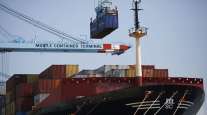Mobile's Interstate 10 Project Could Be Costlier Than First Imagined

[Stay on top of transportation news: Get TTNews in your inbox.]
Critics of Alabama's plan to toll the future Interstate 10 Mobile River Bridge and Bayway project have repeatedly questioned the rationale for building a new 7.5-mile Bayway — a route largely consisting of bridges — between Mobile and Baldwin counties.
They’ve assailed the changes in the project as representative of “Taj Mahal” exuberance and are pointing to the elevated Bayway as the culprit — in 2014, cost estimates were around $850 million; today they are $2.1 billion.
“I don’t understand why the discussion is to raise the Bayway,” said Mobile County Commissioner Connie Hudson on Wednesday, echoing the comments of other coastal Alabama public officials and anti-toll advocates.
The answer, according to the state, is that it’s under federal instructions to respond to warming temperatures and rising sea levels. In other words, the Bayway is being made ready to withstand climate change and newly severe winds, flooding and storm surge.
“If we’re so short-sighted as to just concern ourselves with the immediate, with the next 20 to 30 years, we might get by with that but what are we leaving for the next generation?” said Scott Hagen, director of the Louisiana State University Center for Coastal Resiliency, who has co-written pieces about the effects of rising sea levels on the Gulf Coast.
“Eventually, you have to catch up to how the system has changed and when you play this catch up is when it will really cost you,” said Hagen. “We have to have a vision that is generational.”
Rising costs
The issue erupted during a lively meeting Wednesday between state lawmakers who are feeling anti-toll pressure from the public and the Alabama Department of Transportation team that has been working on the I-10 project for years.
Much of the back-and-forth focused on whether any federal law or federal guideline was steering ALDOT to make the expensive revisions to the Bayway piece of the I-10 project.
Lawmakers who are critical of ALDOT’s recommended $6 one-way toll to pay for the project blame the Bayway redesign for the soaring overall price tag.
But the elevation of the Bayway, according to the state, adds only $350 million extra to the overall cost. The overall price tag for the new Bayway comes in at $880 million, or slightly more than 40% of the $2.1 billion project.

The Interstate 10 bridge that spans Escambia Bay is seen with sections washed away in the aftermath of Hurricane Ivan on Sept. 17, 2004, near Milton, Fla. The storm, along with hurricanes Katrina and Rita in 2005, were taken into the calculation when determining how high the Bayway in Mobile, Ala., should be raised. (Associated Press/Kevin Glackmeyer)
ALDOT Director John Cooper said the requirement to replace the existing Bayway with a newer and taller Bayway comes from Federal Highway Administration guidelines.
“You either do it their way, or you don’t do it,” Cooper told lawmakers on Wednesday. “If I don’t satisfy the Federal Highway Administration, there will be nothing done. I have not spent the past 8-1/2 years of my life begging and cajoling to approve a document just because I like doing it. This is what is required to get to this point.”
But some lawmakers are disputing how much legal weight the guidelines carry.
“If I go back to tell the constituents that the bridge has to be raised to a 100-year level, I don’t think it’s too much to ask and say, ‘Where are the laws?’ ” state Rep. Matt Simpson said.
The existing guidelines were established in 2008, following an analysis of the infrastructure damage that occurred along the Gulf Coast following hurricanes Ivan in 2004, Katrina in 2005 and Rita in 2005.
Bayway Decision
The nonpartisan American Association of State Highway Transportation Officials was another key player in the decision to elevate the Bayway. It’s the entity that developed the guidelines that FHWA sets out for new bridge construction in areas vulnerable to coastal storms.
AASHTO is based in Washington, and represents all 50 state departments of transportation, as well as those in the District of Columbia and Puerto Rico.
While the guidelines that it wrote are not federal law, they are recognized by FHWA as the standard that states must follow to qualify their road projects for federal funding and grants.
“This association works for its member departments and we do not direct the work of our member departments,” said Lloyd Brown, AASHTO spokesman.
ALDOT spokeswoman Allison Gregg said the existing Bayway, which was built in 1977, is “well below the 100-year wave crest elevation, placing it well within the wave impact” of a 100-year storm.
Retrofitting the Bayway to widen it and strengthen it to withstand strong storms would be “more expensive,” she said, than building an entirely new Bayway of 7.5 miles that complies with AASHTO’s specifications.
ALDOT’s design team for the Bayway conducted storm analyses that accounted for sea-level increases.
A 100-year storm isn’t necessarily an event that occurs once every 100 years. Rather, it’s an event with a 1-in-100 chance of occurring in any given year. For a 500-year event, there is a 0.2% chance of it occurring in any given year.
Still, the city of Houston was swamped by three “500-year” flood events from 2015-2017, after Hurricane Harvey inundated the city.
In Mobile, the ALDOT team simulated 80 hurricanes to produce a model of where maximum storm surges might occur. The Bayway was clearly vulnerable to strong hurricanes, such as a Category 3 and above. The Alabama coast hasn’t been hit by such a hurricane in more than a decade.
Coastal engineer Josh Carter, with Mobile-based Mott MacDonald, told state lawmakers from Mobile and Baldwin counties that there is a “65 to 70%” chance of at least one catastrophic hurricane striking the Mobile region within the next 100 years.
Such a hurricane, he said, would destroy the existing Bayway. “That is the reality of where we stand today,” he said.
Distributed by Tribune Content Agency, LLC




